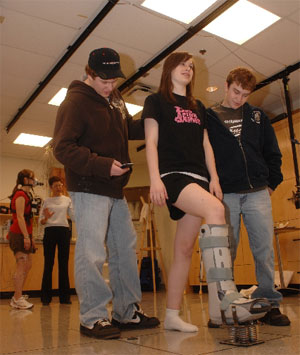 |
| Todd Mercer and Mike MacIsaac give friend Alyssa Moss a hand as she tries out the "alter-leg." (Danny Abriel photo) |
When Todd Mercer and Mike MacIsaac wanted to give their Grade 11 science fair project a test run, they called the H¬ĢĽ≠ School of Physiotherapy.
‚ÄúWe‚Äôve been so impressed with their insight,‚ÄĚ says assistant professor Gail Dechman, who along with her colleague Cheryl Kozey helped the students put their rehabilitation device through the paces. ‚ÄúIt‚Äôs their project, and they knew exactly what they wanted to measure. These guys are really on the ball.‚ÄĚ
The device is called the ‚ÄúAlter-leg‚ÄĚ and is designed to provide an alternative to casts and crutches for rehabilitating a broken foot. The inspiration for the boot, which features springs on its sole, came from an injury that Mr. MacIsaac suffered right before his first year of high school.
‚ÄúI broke my leg in the summer and had to start the school year in crutches,‚ÄĚ explains¬†Mr. MacIsaac, who attends¬†Riverview Rural High School, near Sydney. The experience opened his eyes to the challenges that people face when injured. ‚ÄúI saw how hard it was to move around and to try and carry things.‚ÄĚ
Last year the two students submitted a prototype device to the national science fair and walked away with a silver award, along with other prizes. This year’s model is a revamp and refinement on that original design with particular emphasis on adjusting the pressure of the device to speed up bone growth.
‚ÄúWe incorporated simple laws of physics like Wolff‚Äôs law that bone growth is proportional to the amount of force put upon it,‚ÄĚ explains Mr. Mercer. ‚ÄúWith this, you can tighten the springs to put more pressure on it. You start with an extremely loose spring and make tighter. This should help the bone heal faster and stronger than usual.‚ÄĚ
Since embarking on the original project, the students have made two trips to Dr. Kozey’s lab in the School of Biomedical Engineering to test the device on themselves. They’ve found that it uses less energy and provides better resistance than traditional crutches and casting.
Last Thursday, while in town for the provincial science fair, they made their third visit to test the Alter-leg on two of their classmates, Jonathan MacNeil and Alyssa Moss, as well as their chaperones for the trip. They were each hooked up to electromyography equipment to compare muscle use between regular walking, walking with crutches, and walking using the Alter-leg. They also did a metabolic assessment on each subject to determine oxygen consumption, heart rate and energy use.
The students will take the device and their findings to Ottawa next week for the , hoping to improve on last year’s result. And while they’re still thinking about what they want to do for university in a year’s time, they say that they wouldn’t be surprised if their studies extend the work they’ve done building the Alter-leg.
As for the H¬ĢĽ≠ professors, they were more than happy to help out, as Dr. Dechman put it: ‚ÄúIt‚Äôs really great to be able to facilitate this sort of relationship between the university and the community.‚ÄĚ
